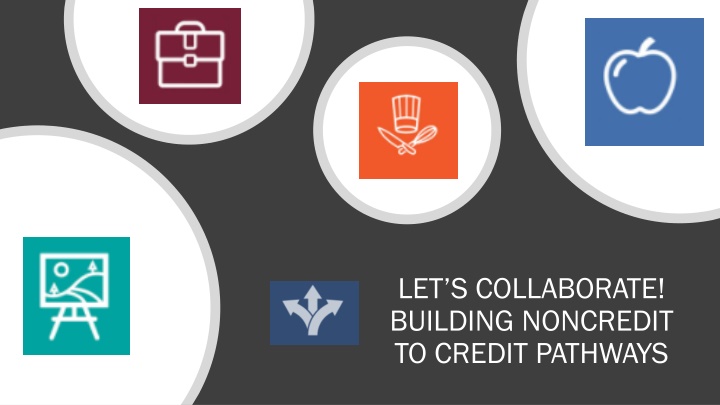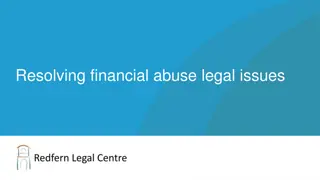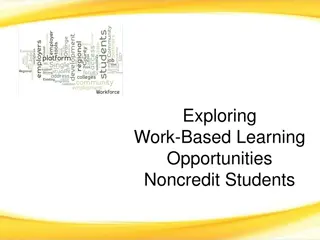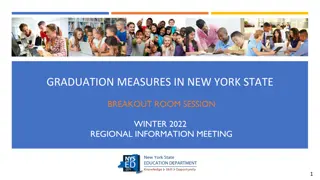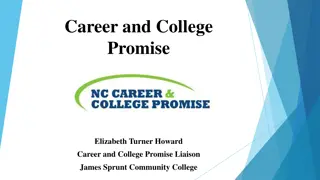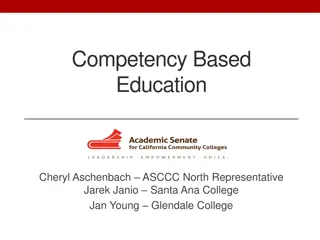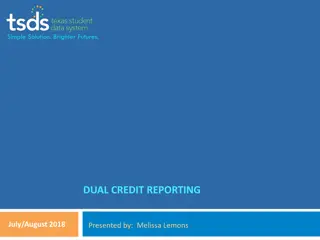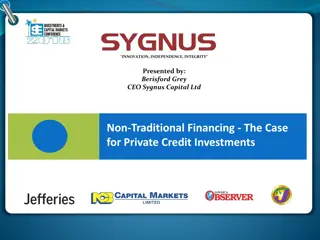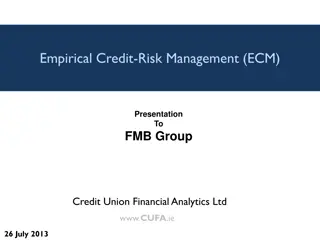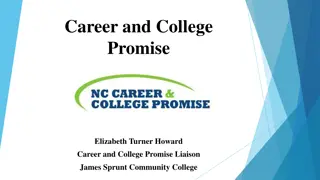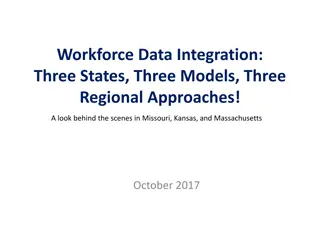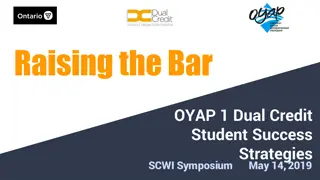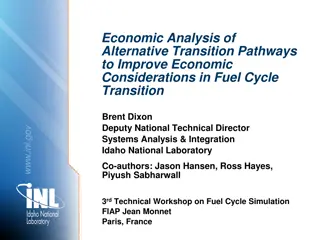Building Noncredit to Credit Pathways: Strategies for Collaboration
Explore key strategies for creating pathways from noncredit to credit education, including understanding diverse audience perspectives, fostering collaboration between institutional subcultures, and addressing challenges in aligning noncredit and credit programs.
Download Presentation

Please find below an Image/Link to download the presentation.
The content on the website is provided AS IS for your information and personal use only. It may not be sold, licensed, or shared on other websites without obtaining consent from the author.If you encounter any issues during the download, it is possible that the publisher has removed the file from their server.
You are allowed to download the files provided on this website for personal or commercial use, subject to the condition that they are used lawfully. All files are the property of their respective owners.
The content on the website is provided AS IS for your information and personal use only. It may not be sold, licensed, or shared on other websites without obtaining consent from the author.
E N D
Presentation Transcript
LETS COLLABORATE! BUILDING NONCREDIT TO CREDIT PATHWAYS
Facilitator Maryanne Galindo Los Angeles Mission Community College Chairperson/Professor A Academic R Readiness, C Career & C Community Institute (ARCC Institute) (formerly Adult Basic Education Department) galindm@lamission.edu Association of Community & Continuing Education (ACCE) Noncredit Council Lead/Board Member Academic Senate for California Community Colleges Noncredit, Pre-transfer, Continuing Education Committee
Overview Overview 1. Speaking into the Listening of Divergent Subcultures 2. 3 Collaboration Strategies to Build Noncredit to Credit Pathways 3. Models of Each Strategy 4. Q&A
Speaking Into Peoples Listening Speaking Into People s Listening Implies: 1. Understanding what the audience is inherently receptive to, and speaking into that space; 2. Accurately hearing what the audience truly wants/expects; 3. Cultural translation of multiple perspectives into the listening of others; 4. Finding the interconnections to foster collaboration Institutional Subcultures Credit Faculty Students/ Community Industry Employers Noncredit Faculty Admin
Speaking Into Peoples Listening Speaking Into People s Listening Understanding Your Audience Campus Culture and Readiness Level 1. 2. 3. 4. 5. 6. 7. What outrageous views have you heard about noncredit? What do your partnering Industry Employers listen for? What are students are listening for? What perceptions influence how credit faculty listen? How does the mission of Adult Ed influence how noncredit faculty listen? What obstacles prevent credit and noncredit faculty from working together? What impacts how administrators listen? Institutional Subcultures Institutional Subcultures Credit Faculty Students/ Community Industry Employers Noncredit Faculty Admin
Speaking Into Peoples Listening Speaking Into People s Listening Check Point: 1. What statements surprised/jumped out at you? 2. As Noncredit Champions, how does such divergence impact you and your leadership?
And you still want to embed noncredit? And you still want to embed noncredit? The invisible work you do: Identify Listening Perspectives Dispel Myths Take People Where They Are Act as a Cultural Translator by Speaking into the Listening of Multiple Stakeholders Build Relationships & Networks (Roadshow) Think Big Picture & Frame the Debate Identify/clarify purpose needs Build Multiple Bridges
Think Big Picture Context: Think Big Picture Context: Where are the interconnections? Where are the interconnections? Integrated Education & Training Equity, Diversity, Inclusion Guided Pathways Student Success CAEP/ AB705 Rising Scholars WIOA/ Strong Workforce Strategically Integrating & Leveraging Statewide & Funding Initiatives
Universal Question How do you get faculty buy How do you get faculty buy- -in? in? Creating an open space for the credit faculty to tell us what they need Speaking into their listening Asking Questions - How familiar are you with noncredit? - Does it fit into an existing pathway? If so, how? - What skills would you want your students to have before they entered your course? - How many hours (units) would this course be? - How do you envision scheduling this program? - Is there an advantage to cohort scheduling?
What those questions reveal What those questions reveal - What skills would you want your students to have before they entered your course? - Helps to determine if they need onboarding, complementary or capstone - How familiar are you with noncredit? - Sell the benefits of noncredit and tailor it depending on how familiar/unfamiliar they are with it (e.g. starting with the basics or just a single selling point) - How many hours would this course be? - Introduce the concept of creating courses based on hours instead of units - Helps with curriculum and how to structure the course (or program) and even future scheduling - Does it fit into an existing pathway? If so, how? - Let s me know if there could potentially be a pathway from noncredit to credit OR is it supporting completion of a credit pathway OR are we starting a brand new pathway? Onboarding Complementary Capstone/ Industry
3 Collaboration Strategies for Building Noncredit to Credit Pathways Capstone/ Industry Onboarding Complementary College Readiness Mirrored Courses Vocational/ Career Prep Support Courses (AB705) Academic Readiness (GED) Sustainability Career Exploration Digital Literacy Community Needs
ALIGNING PRIORITIES: ALIGNING PRIORITIES: LAMC Integrated Strategic Master Ed Plan LAMC Growth Opportunities LAMC Guided Pathways LAMC Local Partners LAOC Regional NC Strong Workforce PATHWAYS THAT BRIDGE COMMUNITY TO THE COLLEGE Enhances foundational skills that support college readiness & success in all 6 LAMC pathways 1) 2) Academic Readiness Certificate 3) Academic Readiness (Bilingual) Certificate 4) Digital Literacy Certificate (Microsoft Office Exam) 5) Pathway to Citizenship Certificate 6) College Readiness Certificate* Job Readiness Certificate *Currently being developed by updating, existing stand alone courses anticipated Winter 2024
ALIGNING PRIORITIES: ALIGNING PRIORITIES: Designing Structures for Equity & Inclusivity Addressing AB705 Guided Pathways GUIDED PATHWAYS, MIRRORED COURSES & SUPPORT COURSES 1) VocEd 110CE: Pathway to Biotech Sustaining the success of a completed grant through noncredit Anticipated Launch Fall 2021 2) ESL Mirrored Courses Launched Spring 2021 First in LACCD 3) Academic Prep Math Support Launched 2020 In response to AB705 4) Academic Prep English Support In early development stage
The Capstone Opportunity: The Capstone Opportunity: CDCP Institutes CDCP Institutes CTE PREP PATWAYS TO CREDIT CTE 1) Sustainable Small Business Development 2) Introduction to CSIT Robotics 3) Introduction to CSIT Social Media 4) Introduction to CSIT Programming 5) Intro to Construction Technologies 6) Digital Media Production & Streaming* 7) Competitive eSports Event Producer* 8) Community Dental Health Coordinator* 9) Non-Traditional Leadership for Community Enhancement* 10) The Art & Practice of Conflict Resolution* 11) Emergency Preparedness Specialist** 12) Community Safety Specialist** 13) Fund Development Specialist** 14) Nonprofit Management** *Coming Soon Spring 2023 **In Development Anticipated Fall 2023
How can one well How can one well- -designed program designed program impact several pathways? impact several pathways? Competitive eSports Event Producer: Certificate of Competency Intro to the multi-billion dollar eSports industry Event & Business Management Graphic Design Guided Pathways Workforce Reentry K-12 ASO (capstone) Programming Transitioning noncredit to credit
Strategy #1: Onboarding Competitive eSports Event Producer Certificate (7 Competitive eSports Event Producer Certificate (7 St.Hrs St.Hrs.) .) Prepares students for entry-level internships in the eSports industry; feeds AMP pathway & Business Administration pathway; provides infrastructure to existing eSports club in ASO; attracts new students and universities to LAMC via this emerging, multi-billion dollar industry. VOC ED 882CE VOC ED 883CE Competitive eSports Event Production VOC ED 881CE Tech Planning for LAN Events eSports Event Management & Livestreaming (3) (1) (3) Completed in 1 semester (two 8-week sessions) & 1 intercession Fall Fall Winter Spring Session 1 Spring Session 2 Summer Session 1 Session 2 eSports Event Management Technology Planning for LAN Events & Livestreaming Competitive eSports Event Production eSports Event Management Technology Planning for LAN Events & Livestreaming Competitive eSports Event Production
Strategy #1: Onboarding Strategy #2: Complementary Strategy #3: Industry/Capstone Digital Media Production & Streaming Certificate (6 Digital Media Production & Streaming Certificate (6 St.Hrs Prepares students entry-level internships; feeds credit AMP certificates and degrees; provides infrastructure for future LAMC Internet Radio (podcasts) St.Hrs.) .) VOC ED 872CE VOC ED 873CE VOC ED 871CE Digital Media: Audio Storytelling Digital Media: Podcast Production & Live Streaming Digital Media: Video Storytelling (2) (2) (2) Completed in 1 semester, in three 5-week sessions Fall Fall Fall Spring Session 1 Spring Session 2 Spring Session 3 Session 1 Session 2 Session 3 Audio Storytelling Podcast Production & Live Streaming Video Storytelling Audio Storytelling Podcast Production & Live Streaming Video Storytelling
Strategy #1: Onboarding Strategy #2: Complementary Strategy #3: Industry/Capstone Sustainable Small Business Development (12 St.Hrs.) Sustainable Small Business Development (12 St.Hrs.) Introduces students to core entrepreneurship competencies; scheduled for targeted audiences in a cohort model; supports exploration & idea formation; serves departmental goals for onboarding or capstone projects; connects with potential incubation services offered by community partners. VOC ED 190CE VOC ED 191CE VOC ED 192CE VOC ED 193CE VOC ED 194CE VOC ED 195CE Pathway to Socially Responsible Entrepreneurship Starting Your Own Small Business Managing Small Business Operations Marketing & Sales for Small Business Technology for Small Business Entrepreneurial Finance (2) (2) (2) (2) (2) (2) Co-teaching & IET delivery model Contextualized for specific industry sectors & LAMC s 6 Guided Pathways Spring Session 1 Spring Session 2 Fall Fall Winter Summer Session 1 Session 2 ESL/ESLNC BS Comp. VocEd 190CE VocEd 191CE VocEd 192CE VocEd 193CE VocEd 194CE VocEd 195CE ESL/ESLNC BS Comp. VocEd 190CE VocEd 191CE VocEd 192CE VocEd 193CE VocEd 194CE VocEd 195CE
Strategy #2: Complementary Complementary Noncredit Courses: Nursing Basic skills improvement for credit healthcare career programs Contextualized basic skills math course Covered dosage calculations, measurements, decimals, percent, proportions, and fraction
Complementary Noncredit Courses: Nursing 4-week pre-requisite (Nursing) 229 students have completed healthcare math since Summer 2017 Overall, 98% of the students who took healthcare math have passed pharmacology * 34 additional students enrolled in HCM1 in Summer 2021 and are currently enrolled in Pharmacology in Fall 2021
Complementary Noncredit Course: Welding English for Special Uses (ESU) Contextualized ESL course Collaboration between credit Welding faculty and noncredit VESL faculty Pre-taught welding concepts and vocabulary before introduction to welding course
Noncredit SWP Metrics LA Region Project Year 1 2016-17 Project Year 2 2017-18 Project Year 3 2018-19 Project Year 4 2019-20 % Increase from 2016 LA REGION Number of Enrollments, Noncredit CTE Courses Number of Students Who Earned Noncredit Vocational CDCP Certificates Number of Students Who Earned Noncredit Milestone 33,437 35,317 38,022 40,144 20% 628 766 1,063 2,125 238% Data Not Available 7,366 7,912 8,255 12% View data reports by college
Career Development and College Preparation (CDCP) Certificates Developed in Project Sector/Discipline Health Energy, Construction and Utilities Business/Entrepreneurship Retail, Hospitality, Tourism Workforce Preparation ICT/Digital Media Advanced Transportation and Logistics Public Safety/Education Total Count of Certificate 42 40 33 32 29 14 7 3 200
A Brief A Brief Cautionary Cautionary Tale Tale
Think Tank Time! Pondering the Possibilities Pondering the Possibilities 1. What noncredit certificate are you considering? 2. Who is the audience? 3. Which of your campus pathways does it connect with? 4. Which strategy (or strategies) will your model use to embed noncredit? (onboarding, complementary, capstone) 5. Identify the top 3 initiatives that you can leverage. 6. Do you have a champion in mind? Who are your allies? Bridge Equity Gaps Foster Inclusivity Sustainability Integrated Education & Training Equity, Diversity, Inclusion Guided Pathways Student Success CAEP/ AB705 Rising Scholars WIOA/ Strong Workforce
Continued Reflection Questions for Deeper Inquiry: How do you get faculty buy-in? What do you do to get better at your craft? How could I have framed that conversation better? Why don t you engage (credit faculty, a department, a certain admin)? What will you do differently? Who are my champions? (will lead) Who are my allies? (will lead from behind vote, etc.) How can you increase disciplined reflection? How do you know if something is feasible? Readiness level (faculty, dept.) Why do you do what you do? What have you learned from a project that fell short of the intended benchmarks of success? To reach your success, what do you need to get better at and how are you going to get better at it? What does your program need to attract the next level of success?
Q&A.Feedback Maryanne Galindo Maryanne Galindo Chairperson/Professor A Academic R Readiness, C Career & C Community Institute (ARCC Institute) (formerly Adult Basic Education Department) galindm@lamission.edu lamission.edu/academics/arcc
